John Coates' Family History Pages
The information and photos
on this page are from many sources. We have done a lot of research ourselves,
especially searching through old newpapers and BDM records and visiting places
of interest in Scotland, New Zealand and Australia. The assistance of
other family-history-minded members of the extended family has been invaluable,
including Roger Murray, the late Arthur Murray, John Seaton,John and Anthony
Beale. Please
contact me if you
have additions, corrections or questions. I would particularly like to hear from
you if you are related to
our branch of the Murray family.
William Montague Murray and Elizabeth McEwan
William Montague Murray
My great-great-grandfather, William Montague
Murray (1820-1880), was born William Murray in Glasgow on 19 June
1820. (The extra name Montague appears to have been added for his
theatrical activities when he was a young adult.) His father's name
was also William Murray, his mother Unnie McLean; their marriage was recorded
as:
William Murray, tailor, and Unia
McLean were married on 27 November 1807 by John McKenzie minister of
New Gaelic Chapel, Glasgow.
The fact that they were married in the New Gaelic Chapel suggests
that at least one them was Gaelic-speaking and came from the
Highlands. Murray is a name from the Perthshire Highlands.
Baptismal records show that they had 5 children:
- Charles Murray, born 2 October 1810 in Glasgow
- John Murray, born 24 August 1815 in Glasgow
- Christian Murray (female), born 10 December 1817 in Glasgow
- William Murray, born 19 June 1820 in Glasgow
- Hugh Murray, born 25 February 1823 in Glasgow (mother’s name written as “Anie”)
At the time of his death, in Hay in
January 1880, William Murray was said to be
60 years old. The death certificate stated that his father’s name was Donald and
that he was born in Edinburgh, but his obituary stated Glasgow, and all other
references from his past, including his schooling and on the birth certificates
of his children, confirms Glasgow as his place of birth. While it is not
possible to be absolutely certain, the evidence points to his having been born
in Glasgow on 19 June 1820 to parents William Murray and Unnie McLean, which would mean he was 59 at the time of his death. The discrepancy can
be explained, as is often the case, by surviving family members rounding up "ïn
his sixtieth year" when providing information for death certificates
and obituaries or having only partial awareness of the details. The evidence
about the correctness of the parents' names is: there was no William
Murray born in Edinburgh or Glasgow in 1819-1820 with father’s name Donald; all
other information about William Murray refers to Glasgow; there was one William
Murray born in 1819-1820 to a father who was a tailor (as he himself became, it
being most common for a son to take up the same trade as his father), and this
birth was in Glasgow. (Of the other three William Murrays born in Glasgow in
1819-1820, aspects of the registrations, such as second given names, tend to
rule them out.)
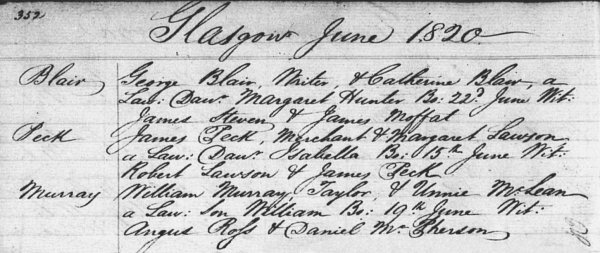
Baptism record for William Murray
In the baptismal record of four of the children, including William,
the father's occupation was "Taylor". At the time of Charles' birth,
he was apparently performing his service in the reserves, as he was
listed as "Soldier in the Lanarkshire Militia".
The witnesses varied, but it is
interesting to note that a George Murray was a witness for Christian
and Hugh, and a Charles Murray was a witness for Hugh. Perhaps they
were relatives. An Angus Ross was a witness for two of the births,
those of Christian and William.
William served an apprenticeship to become a tailor (it can probably
be assumed that he was apprenticed to his father) and attended the Highland Society
School, a charity trades school for those whose parents had come to
Glasgow from the Highlands. It was largely funded by the proceeds of the Black Bull Tavern.
Elizabeth McEwan
My great-great-grandmother, Elizabeth McEwan (1822-1864), was born in Crieff, Perthshire, Scotland and was baptised on 16 March 1822 (birth date not recorded). Her parents were David McEwan and Catharine McLaren.
Elizabeth's death
certificate in 1864 gave her parents’ names as John and Catherine,
and born Perth, Scotland, but the information
recorded at her death
may in error, especially given the circumstances (see later). Family records state she was born in Crieff,
near Perth.
The baptism records for Crieff show the children of David McEwan and Catharine McLaren as:
- Elizabeth McEwan, baptised 16 March 1822 in Crieff, Perthshire
- Peter McEwan, baptised 27 July 1823 in Crieff, Perthshire
- David McEwan, baptised 4 September 1825 in Crieff, Perthshire
- Mary McEwan, baptised 5 April 1828 in Crieff, Perthshire

Baptism record for Elizabeth McEwan
Elizabeth McEwan and William Murray marry in 1839
On 17 September 1839, William Murray and Elizabeth McEwan were married in Glasgow. Assuming the above birth information is correct, they were 19 and 17 years old respectively. Six weeks later, they were passengers on the Bengal Merchant, leaving Scotland to migrate to New Zealand. Their ages as stated on the shipping list were 21 and 19. There is a family story that they eloped and were married on the ship, but there is a reference to only one marriage on the ship, and that was of a different couple. Perhaps the story is based on their being under age and possibly marrying without parental permission; maybe they did not reveal their intent to sail to New Zealand together.

Marriage record for Elizabeth McEwan & William Murray
The migration to New Zealand in 1839
In 1839 there was a meeting in Glasgow sponsored by the Duke of Hamilton, the Duke of Argyll and the Lord Provost of Glasgow to encourage colonisation schemes to New Zealand. The New Zealand Company was essentially active in the South and the West of England and all the other ships in this venture sailed from either London or Plymouth. However, they had an agent, Mr Crawford, in Glasgow and one ship, the Bengal Merchant, went from Scotland.
 The 500 ton
Bengal
Merchant, commanded and owned by Captain John Hemery (age 29), was commissioned by the New Zealand Land Company to take Scots
emigrants to the new settlement. Dr F. Logan was the surgeon
superintendent and naturalist; the Rev John Macfarlane was the
minister to the colonists; Mr Alexander Marjoribank was the
historian of the voyage. The departure of this ship was viewed in
Scotland as an historical occasion; shortly before she left, the
Lord Provost of Glasgow, with a large party, went on board and
addressed the passengers. They sailed from Greenock
on 30 October 1839.
The 500 ton
Bengal
Merchant, commanded and owned by Captain John Hemery (age 29), was commissioned by the New Zealand Land Company to take Scots
emigrants to the new settlement. Dr F. Logan was the surgeon
superintendent and naturalist; the Rev John Macfarlane was the
minister to the colonists; Mr Alexander Marjoribank was the
historian of the voyage. The departure of this ship was viewed in
Scotland as an historical occasion; shortly before she left, the
Lord Provost of Glasgow, with a large party, went on board and
addressed the passengers. They sailed from Greenock
on 30 October 1839.
Marjoribanks' journal records that there were 150 passengers, including 33 children. During the voyage, there was one marriage (a settler and his dairymaid), one birth and one death (a boy from sunstroke). There was dancing occasionally during the early part of the voyage, and Rev MacFarlane gave prayers every night in the cabin, while the steerage passengers gave prayers among themselves. Every Sunday when the weather permitted, divine service was performed upon deck to the whole passengers and crew. With the exception of a gale when off the Bay of Biscay, the weather was pleasant. For 2-3 weeks when crossing the equator, it was 75° to 82°F in the shade and the nights were very oppressive.
Apart from William and Elizabeth Murray, the only other passenger with the name Murray on the Bengal Merchant when it sailed from Greenock was John A. Murray, whose stated age was 25. While that age would fit with that of William's older brother John, the journal written by John A Murray (see below) has no mention of any relationship; also there is other information in the journal that indicates it was unlikely they were related.
William Murray’s obituary stated that he was “tailor to the New Zealand Expedition Company”, but he is recorded as a labourer in the indents. He may have travelled as a labourer to take advantage of a free passage. Similarly, wives of labourers had free passage.
After a voyage of 113 days, the Bengal Merchant arrived in Port Nicholson New Zealand on 20 February 1840, a month after the first migrants had arrived there. They dropped anchor off Petone Beach. As per the terms of the charter, they lived on the Bengal Merchant for three weeks, going ashore every day to build their dwellings. For those first few weeks, the weather was wet and stormy. The first settlement, Britannia, was near a Maori village called Pito-one (now Petone, a suburb of Lower Hutt). Later, the settlement was moved across the harbour to the location of what is now Wellington.
Extract dated 14 May 1840 from John A Murray's
journal written at Port Nicholson:
For the first three or four weeks all parties were busy erecting
dwellings on the beach near the river Hutt. The houses are built of
spars cut from the forest and roofed with long flax-grass and a kind
of flexible cane called supplejack.
We are in Clyde Terrace, and the dwellings are the best in the
Colony. The minister lives opposite where I live. Mr. Macfarlane has
divine service on the beach every Sabbath; also a Mr. Butler, of the
Church of England. The Maoris pronounce my name O'Mare, which
signifies ‘a bad cold'.
William and Elizabeth Murray’s first child, Donald Murray was born on 5 August 1840, just over 9 months after leaving Scotland and 5½ months after arriving at Port Nicholson. There is a family story that Donald was the first white child born “on that island and the fifth in the whole of New Zealand”. However, the first white child born in the North Island was Thomas Holloway King, born in 21 February 1815, at Rangihoua in the Bay of Islands. Three people were claimed to be the first European child born at Port Nicholson: Thomas Rogers, W. Dorren and L. Holmes (all born 1840, when there were 22 births at Port Nicholson). Donald Murray may have been the fifth white child born in Port Nicholson.
By November 1840, 22-year-old William Murray (who was advertising that he had studied fashions while on the continent of Europe) was already well established as a tailor in Port Nicholson, was moving to new premises, and was advertising for a coat maker and an apprentice.
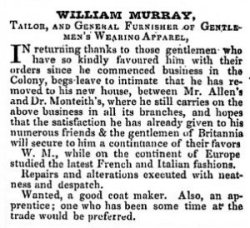
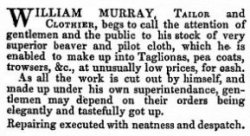

New Zealand Gazette and Wellington Spectator, 26
December 1840, 31 July 1841 and 8 December 1841
But, in December 1841, less than two years after arriving, Mr W. Murray, Tailor, was selling his house and shop in Port Nicholson.
The Murrays relocate to Nelson on the South Island
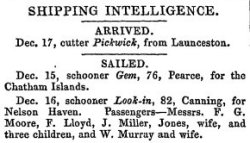 By 1841 the New
Zealand Company was looking for a larger area to form a new
settlement and Maori Chief, Te Rauparaha, agreed to a settlement
in the Nelson area in the South Island. On 1 November 1841 the
Arrow, with surveyors on board, sailed into the Nelson Harbour
and chose Whakatu as the site for the settlement. It was named
Nelson after Admiral Lord Nelson and a number of street names are
associated with his naval campaigns in the Napoleonic wars. Captain
Arthur Wakefield chose the summit of Church Hill (Pikimai) to erect
the pole which marked the base of his survey and laid off from it
Trafalgar and Nile Streets to be the two main thoroughfares.
By 1841 the New
Zealand Company was looking for a larger area to form a new
settlement and Maori Chief, Te Rauparaha, agreed to a settlement
in the Nelson area in the South Island. On 1 November 1841 the
Arrow, with surveyors on board, sailed into the Nelson Harbour
and chose Whakatu as the site for the settlement. It was named
Nelson after Admiral Lord Nelson and a number of street names are
associated with his naval campaigns in the Napoleonic wars. Captain
Arthur Wakefield chose the summit of Church Hill (Pikimai) to erect
the pole which marked the base of his survey and laid off from it
Trafalgar and Nile Streets to be the two main thoroughfares.
On 16 December 1841, the Murrays sailed to Nelson on the Look-in (New Zealand Gazette and Wellington Spectator, 18 December 1841). On 1 February 1842, the settlement of Nelson was officially founded with the arrival of the first settlers on the Fifeshire.
It was later reported (The Nelson Examiner, 9 April 1842) that William Murray had moved to Nelson “with the intention of opening a public house”. However, by April 1842, Murray had been unable to obtain a liquor licence, despite his best efforts; in fact “no licenses had been granted to the district, and no means of obtaining them had been pointed out by the Government”. So he opened the Caledonian Inn for business anyway.
He was charged with selling liquor without a licence (despite several others doing the same). On the night in question, Murray admitted he had sold liquor. Evidence was given there was a fiddler and people danced; one man struck another in the face; that these men were immediately turned out and prevented from fighting; that Mr Murray endeavoured to the utmost to keep order, and that he succeeded in stopping indications of unruliness in some of his customers; and that liquor was refused to be served by him after 10 o'clock at latest. Further evidence was given of other evenings when he had admitted into his house certain disorderly and riotous persons, whom he was unable to restrain from somewhat riotous proceedings. Uproar had apparently taken place at Murray's on the previous Sunday night. He was fined £30, an excessive amount at that time. There was public outrage. It was considered that Murray had been charged and fined excessively as a way of punishing him for keeping a disorderly house, despite his best efforts to maintain order. It was also pointed out that he had been fined for an offence for which he had not been charged.
The case was taken up in Public Meetings and reported in newspapers, with widespread support for both Murray and the principles involved – “inflicting a fine for the commission of one offence because the law does not enable you to punish for a supposed offence of a different character”. There was also outrage that Murray had not been able to obtain a licence and if his public house was not open “the public would be placed in the predicament of having no house for refreshment or entertainment”.
“True, he is a Scotchman, and keeps a grog shop; but there are other Scotchmen who keep grog shops. William Murray is not damned because many publicans are sinners, any more than a magistrate is saved because there are Pharisees in Heaven”.
The resolutions of the Public Meeting were to “be advertised in the Nelson Examiner, and that placards containing copies thereof be posted throughout the town without delay”. The money for Murray’s £30 fine was raised by public subscription. At no stage was Murray’s young age – presumably 22 years old – raised as a relevant issue.
Extracts relating to Murray's case from the Nelson Examiner and New Zealand Chronicle, April 1842.
The irrepressible William Murray expands his business interests
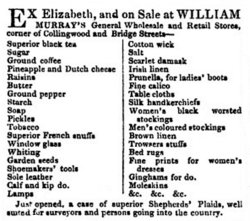

It appears that, for a time, Murray was forced to abandon enterprises that required a liquor licence. He commenced selling general merchandise and again opened a business as a tailor. (Nelson Examiner and New Zealand Chronicle, 15 October 1842)


By late 1842, Murray had his house and stock for sale (Nelson Examiner and New Zealand Chronicle, 19 November 1842 and 10 December 1842) and was apparently getting ready to return to his preferred business activities, which involved alcohol and entertainment. In April 1843, he was finally granted a licence for the Caledonian Inn. Murray was in the second group of licences to be issued. The first eight licences had finally been issued in April the previous year, as a result of the outrage following his arrest and fine.
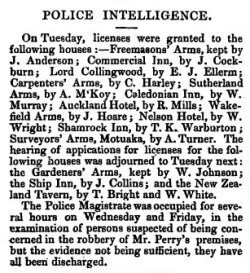
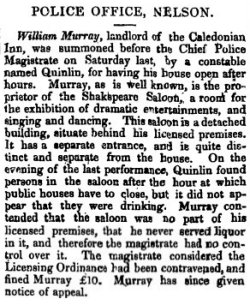
Nelson Examiner and New Zealand Chronicle, 22 April 1843 and 27
April 1844
Around this time (c1842), William and Elizabeth Murray’s second child was born: Catherine (Kate) Murray. It has been said in the family that she was the first white child born in Poverty Bay, which is on the North Island near Napier and was a remote whaling station at that time. It is more likely she was born in the Nelson area where the Murrays were living, but no record has yet been found of her birth. It is possible she was the first white child born in the Nelson area.
In July 1843, William Murray’s name was on a long list of people signing several petitions in Nelson re “an erroneous statement calculated to convey an impression unfavourable to the memory of our lamented fellow colonists who fell in the late massacre at the Wairoo”. The Wairau Affray (17 June 1843) was the first serious clash of arms between the Maori and the British settlers after the signing of the Treaty of Waitangi, and the only one to take place in the South Island.
It was the culmination of the NZ Land Company’s illegal acquisition of land from the Maori. When negotiations broke down, a Chief destroyed the survey pegs and thatched huts on his land, which led to Magistrate Thompson (Murray’s nemesis) issuing a warrant for the Chief's arrest. An armed party was sent to arrest the Chief, but apparently its leader, Thompson, behaved aggressively. Fighting broke out after the settlers fired the first shot, which killed a Chief’s wife. Four Maori died and 22 British settlers, of whom some were killed after surrendering to the Maori, as revenge for the shooting of the Chief’s wife. The dead included Thompson and Captain Wakefield of the NZ Land Company.
The incident heightened fears of an armed Maori insurrection among settlers. Church Hill in Nelson was fortified and for some months the settlers retired there with their families at night. The news of what had happened and uncertainty about how far the fighting might spread meant that further immigration was suspended. With no new settlers bringing capital to Nelson the settlement developed only slowly; those who stayed suffered from food shortages. Conditions did not begin to improve until later in the 1840s; by then the Murrays had left.
In April 1844, William Murray was the proprietor of the Shakespeare Saloon, a room for “dramatic entertainments, singing and dancing”, situated in a separate building behind the Caledonian Inn, his licensed premises. Constable Quinlin found persons in the saloon after a performance, even though it did not appear that they were drinking. Murray was charged with contravening the Licensing Ordinance. Murray contended that the saloon was not part of his licensed premises and he never served liquor there. He was fined £10 and gave notice of appeal.
Extract from: Allan, R. (1965).
Nelson: A history of early
settlement Wellington, N.Z.:A.H. and A.W. Reed, pp.144-146
which describes the history of the licensed premises in early
Nelson, William Murray's Shakespeare Saloon, and its contribution to
the debut of theatre in Nelson.
The Murrays leave New Zealand for Australia


Nelson Examiner and New Zealand
Chronicle, 19 October 1844 and May 1845
On 26 May 1845,
William Murray sailed from Nelson to Sydney on the ‘Star of China’,
arriving there on 18 June 1845. It is thought that Elizabeth and the
children had preceded him. William's obituary states only that he
went to Sydney and to Melbourne. A stillborn child was born in
Sydney on 28 September 1845, but no other record has been found
until the birth of the twins Christina and Barbara in Melbourne in
1849. At that time, Murray's occupation is recorded as a tailor in
Little Collins Street, Melbourne.
Elizabeth and William Murray's children
Elizabeth McEwan and William Montague Murray had 7 (or possibly 8) children:
- Donald Edgar Murray was born 5 August 1840 in
Port Nicholson, New Zealand; he died 7 July 1929 in Lidcombe,
NSW, Australia. He married Mary Ann Spear (1854-1945) in 1875 in Hay, NSW. They had 9 children.
- Catherine Murray (aka Kate) was born about July 1844 in
Nelson, New Zealand. On 18 July 1867 in Ballarat, VIC, she
married Johan Santen, born c.1838 in Weener, Hanover, Germany,
an upholsterer. They had one child, Hermann Santen, born 24 July
1869 in Ballarat, who died aged 4 months. They went to live in
Germany and no further information has been found.
- Baby Murray (stillbirth) was born and died on 28 Sep 1845 in
Sydney, NSW, Australia.
- Barbara Murray, twin to Christina, was born 10 July 1849 in
Melbourne, VIC, Australia, and baptised 30 September 1849 at St
Peter's, Melbourne; she died 26 March 1928
in Cootamundra, NSW, Australia. She married (1) Warwick Calmady
Coates (1847- 1878) on 3 March 1870 in Talbot, VIC; they had 4
children. She married (2) Warwick's brother John Lamb Coates
(1840-1929) on 14 September 1880 in Hay, NSW. They had 3
children.
- Christina Murray, twin to Barbara, was born 10 July 1849 in
Melbourne, VIC, Australia, and baptised 30 September 1849 at St
Peter's, Melbourne; she died age 4 months in about November
1849.
- John Robert Murray, aka William - no birth record found,
baptised 7 Jul 1851 [Presb 9272/1851, parents William (tailor) &
Elizabeth]; listed as William on his younger
sister's birth record as born about 1852; later performed
highland dances as Willie Murray, on tour with his father.
- Elizabeth Murray was born 7 Oct 1854 in Melbourne, VIC,
Australia; she died aged 7 days on 14 October 1854.
- Harry Murray - no birth record found, but possibly born about 1856; mother is described as having an infant child in 1859 in Beechworth; later performed as Harry Murray, on tour with his father (South Australian Weekly Chronicle 29 December 1866); may have been "the boy that sleeps in the air" who was referred to as Montague Murray's son, started performing in 1862, and was estimated by a reviewer to be 8 or 9 years old in 1865.
Elizabeth Murray née McEwan and family in Beechworth from 1857
Alluvial gold was discovered in 1852 at the present site of Beechworth, attracting thousands of diggers to the area. By 1857, the population in the Beechworth area had increased to almost 20,000, with 4000 residing in the township itself. Churches, banks, stores and hotels, as well as a hospital had been established.
Many Chinese miners made their way to Australia during the gold rushes. Although they were largely quiet, peaceful and industrious, a considerable number of them had acquired what were seen as bad habits such as opium smoking and gambling. Anti-Chinese sentiment was widespread; a poll tax had been placed on Chinese arrivals in Victoria in 1855, but the Chinese avoided it by walking from Robe in South Australia until that state introduced a similar tax.
In 1857, an estimated one thousand Chinese resided on Spring Creek immediately opposite the Beechworth township, where they were reported to be living in low canvas tents, crowded closely together. They were successfully working claims where it was formerly supposed that the ground had been thoroughly exhausted (Ovens and Murray Advertiser, 1 Jan 1857). This led to animosity and an Anti-Chinese League was formed in Beechworth in 1857, with a strong desire to have the Chinese expelled from the colony.
Advertisement for opium (Ovens and Murray Advertiser,
18 Apr 1857)
It was estimated that one in four of the Chinese were addicted to opium, so the Victorian and NSW governments decided to impose a 10 shillings per pound import duty as a revenue raising measure. Opium was at that time legal and a common constituent of patent medicines, the most popular of which was the widely used laudanum, a mixture of opium and alcohol.


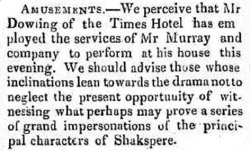
Ovens and Murray Advertiser,
11 May 1857 and 12 October 1857 and 12 October 1857
The Murray family first appear in the Beechworth area when "Mr W. M. Murray, Scottish Comedian, Comic Humorist, &c." placed a series of advertisements in the Ovens and Murray Advertiser, from 11 May 1857. He was organising a "Grand Bal Masque and Venetian Carnival" at the Crow Hotel, Silver Creek, in the Beechworth area. If the ladies of the goldfields were inconvenienced by not having anything suitable to wear, "Dresses to be had of Mr Murray at the Crow Hotel". A similar event was advertised for Wangaratta the following month.
Over the following few months, Murray's Company performed drama, including Othello, a series of grand impersonations of the principal characters of Shakespeare, and other sundry entertainments at the Assembly Rooms and various hotels in the area.
William Murray and his Company appear to have left the Beechworth area in late 1857, for the Maryborough goldfields area. His wife, Elizabeth Murray, stayed behind with her infant son. She was reportedly receiving some money from her husband, but was living in destitute circumstances in a tent in Spring Creek, the area largely populated by the Chinese. She was suffering from a cancer of the face and was probably in considerable pain, which she may have attempted to alleviate with the readily available opium.
In January 1858 Elizabeth Murray was charged with lunacy and in July the following year her circumstances came to the attention of the Beechworth Council.
Elizabeth Murray, wife of the "celebrated impersonator," was brought up charged with lunacy. The apprehending constable said that he found Mrs. Murray lying amongst a quantity of brushwood; he had been informed that she was not of sound mind and therefore took her in charge. Dr. Dempster deposed to the fact of her being of unsound mind brought on, in his opinion, by intense suffering from a cancer in the face. The unfortunate woman presented a most melancholy spectacle. His Worship ordered her to be sent to the Hospital with a view to her receiving proper treatment, and directed enquiries to be made as to whether her husband had left her in the miserable state of destitution in which she was found. (The Ovens and Murray Advertiser, 30 January 1858)
Council minutes
. . . From Messrs. Mellish and Larkworthy, respecting the destitute
condition of Mrs. Murray of Spring Creek; stating that she was
suffering from an incurable cancer in her face — that she had been
in the Hospital on two occasions, and was not again admitable — that
the woman had an infant child, and the case was one of
heart-rendering misery, and one calling for the assistance of the
Council.
Mr. J. K. Brown said that were relief granted in this particular
case, we should see persons in a destitute state from other parts of
the district moving into the Municipality; and suggested that a
Benevolent Society should be established in the town. That a good
deal of destitution existed in the town. Mr. J. S. Clark said he did
not consider that destitution existed to anything like that extent
which Mr. Brown had stated it to be. He thought that £5 or £10 would
meet the case, and that the Council were justified in devoting that
amount for the purpose. The Chairman observed that the Council had some time since
written to the Directors of the Benevolent Asylum in Melbourne
offering to subscribe to the funds of that institution £100 per
annum if they would receive such patients as were sent to them from
this place, but only a qualified reply was received. He considered
that it was now time to institute a Benevolent Asylum in this town,
as the Government paid to such institutions
£2 for every one pound.
To stand over for a week.
(The Ovens and Murray
Advertiser, 11 July 1859)
THE CASE OF MRS. MURRAY.
The Chairman brought under the notice of the Council the case of
Mrs. Murray; who was in destitute circumstances, and stated that
steps were being taken to ascertain if her husband was not in a
position to support her. The further consideration of the case was
ordered to stand over for another week. (The Ovens and Murray
Advertiser, 16 July 1859)
MRS. MURRAY’S CASE
The Chairman stated that steps had now been taken to relieve the
case. Mr. Bookey had sent enquiries to Maryborough on the subject.
Mrs. Murray had received small amounts from her husband. The Town
Clerk on visiting her tent found the place in a most deplorable
state. The Chairman had authorised the expenditure of £1 towards her
temporary relief. The Chairman was authorized to grant her £2 per
week for her maintenance in the Beechworth Hospital. Cr. F. Brown
moved and Cr. Clark seconded a motion; that the Town Clerk be
instructed to cause Mrs. Murray to be admitted to the Hospital; and
that the Council defray her expenses to Melbourne, to get admission
into the Benevolent Asylum. (The Ovens and Murray
Advertiser 3 July 1859)
MRS. MURRAY'S CASE.
The Chairman stated in reference to this affair, that Mrs Murray had
received £2 from her husband, had expressed herself as unwilling to
go into the Hospital and that she could not understand what either
the Council or the public had to do with her, and that her
neighbours had been extremely kind to her. The matter was therefore
dropped. (The Ovens and Murray
Advertiser, 30 July 1859)
The outcome of this case makes it clear that Elizabeth Murray did not want to be sent to hospital or to the Benevolent Asylum in Melbourne. She felt well supported by her neighbours (the Chinese community?) and wanted to continue in her current situation without interference. It is not known whether having her infant child (presumably Harry) in her care was part of this decision.
On 16 March 1861, there is a record in the Ovens and Murray Advertiser of William Murray living back in Beechworth, along with other members of his family, when David Kennedy was summoned for detaining Murray's goods.
At some point before early 1862, William Murray and his company (including most or all of his children) left to go on tour again, leaving his wife, Elizabeth, behind. Murray appears to have made arrangements with the local clergyman for the lease and rates to continue to be paid on a small dwelling on Crown land on the far side of Spring Creek, on the outskirts of Beechworth. Elizabeth's occupation is listed as servant at the time of her death, so she may have been supporting herself by providing services to the local clergyman, or to others in Beechworth.On 23 June 1864 Elizabeth Murray was committed to Beechworth gaol as “a dangerous” (the Beechworth Lunatic Asylum, later known as Mayday Hills, had not opened at that time). She was bedridden all the time she was in the gaol, was apparently well cared for, and never left alone. She took food freely, but daily grew weaker. After several weeks, and a fortnight before her death, a warrant was obtained for her removal to Melbourne Lunatic Asylum. She was not removed because the medical officer certified she was unable to bear the journey.
Elizabeth Murray née McEwan died on 1 August 1864 of “chronic disease of the brain, attended with partial paralysis, blindness and deafness”. She also had “old standing disease of the bones of the face”. She was age 43 and described as a servant; there are no details of her marriage or children on her death record. Because she died in the gaol there was an inquest, which gives reassuring details of the quality of care she was given there.
Montague Murray’s Dramatic Troupe
“Early in life he acquired a taste for theatricals, and we have
listened with pleasure to his happy recital of humorous incidents
connected with the band of amateurs of which he was a member.”
“Mr. Murray’s previous business of catering for public
amusement took him to every place where men do congregate.”
After New Zealand, “he moved to Sydney and to Melbourne, from which
places he made tours of the country with a company of theatricals in
his pay – money sometimes flowing in upon him – at other times ‘dead
broke'.” (from W M Murray obituary 1880)
For a period of about 13 years, from at least 1857, William Murray toured Australia with his troupe of entertainers. They travelled as far north as Rockhampton, and west across to Adelaide. Their journeys can be traced through a series of advertisements and reports in local newspapers. Most of their performances were in country towns and isolated settlements such as gold diggings.
Amusement seekers will find their requirements agreeably satisfied during the tour of the Murray Troupe through Bacchus Marsh, Myrniong, Ballan, Gordons, Egerton, Simmon's Reef and Barry's Reef. The company will appear at the first-named place on Monday and Tuesday evenings next, performing at Ballan most probably on Thursday evening. (The Bacchus Marsh Express, Saturday 31 August 1867)

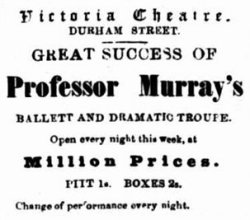

The Argus
16 February 1860 and
Bathurst Free Press and Mining Journal,
5 February 1862 and The Goulburn Herald
and Chronicle,
14 June 1862
. . . During the interlude a mesmeric performance took place. A child, apparently eight or nine years of age, is shown standing on a chair. Under the left arm is an upright stick or support, having feet to keep it steady; a similar stick without feet is then placed under the right arm, next certain supposed mesmeric passes are made, the child opens and shuts its eyes, and at last the head falls on the right shoulder, as if asleep; the chair is removed, and the child appears without any support, save the two upright sticks; one of those being removed, the child appears supported by one only. The body is then placed in a recumbent position, and remains so without any other support than the one stick. (The Maitland Mercury & Hunter River General Advertiser 14 November 1865)
Murray's son Donald Murray performed with the troupe until at least 1867. He acted in drama and performed Irish songs and comedy. He sometimes used the name Daniel Murray, but more often he was Daniel O'Neil, the "Great Irish Comic Singer".
Master Daniel Murray was often applauded in
his popular Irish songs. (The Maitland Mercury & Hunter River
General Advertiser, 18 April 1865)
Mr. Daniel O'Niel is a low comedian of real talent, and should be
capable of taking a good position on the stage. (The
Bacchus Marsh Express, 22 June 1867)
Mr. DANIEL O'NIEL,
Mr. D. O'Neil was the best delineator of Irish characters we have seen for a long time. (The Bacchus Marsh Express, 8 February 1868)
From 1863-1866, Murray's son William performed the Highland Fling as Master Willie Murray.
Irish Comic songs were sung by Mr D. Murray,
and Master Willie danced in good style the Highland Fling. (Border
Watch, Mount Gambier, 25 December 1863)
The clog and sailors' hornpipes, and the picturesque Highland
fling were each admirably danced by Master Willie whose histrionic
abilities also are of no mean order. (The
Kiama Independent, and Shoalhaven Advertiser
22 June 1865)
The clog dancing was good, and Mr. W. Murray was encored in the
Highland fling. (The Darling Downs Gazette and General Advertiser,
Toowoomba, 30 August 1865)
From 1863, Miss Marion Melville was the star of the show, and remained its principal attraction for the rest of the decade. She danced and performed dramatic roles to much acclaim. In the late 1860s she started taking dramatic roles with other companies, returning to the Murray troupe in between. Even after the Murray troupe had folded, she did some solo performances with Montague Murray describing himself in advertisements as her "Stage Manager". She later went on to have a long career in theatre, performing until 1899.
Murray's daughter Barbara Murray joined the troupe for a brief period in late 1866 and early 1867 on a tour of South Australian towns. She performed as Blanche Murray, acting and dancing.
KINGSTON
The Murray Troupe - On Wednesday evening the
Murray Troupe, consisting of
Messrs. D. and M.
Murray,
Miss Melville, and Miss Blanche
Murray, made their first appearance in the Victoria Theatre. They
were welcomed by a fair house, rather above the average of a stock
night. The performances were very varied, ranging from broad farce
to the Highland fling, and the talents of the performers shone
respectably in every part.
Miss
Melville, who seemed to be the
directing genius of the company, showed very considerable dramatic
ability. Her dancing was also good. Both of the male artists
displayed not merely experience of the stage, but originality and
spirit. The programme was gone through with
eclat, and the audience
were correspondingly literal with their applause. The farce was from
beginning to end followed by roars of laughter. The entertainment
will, we understand, be repeated this evening. (South Australian
Register, Thursday 27 December 1866)
On Thursday, December 27, the Murray Troupe gave an entertainment at the
Victoria Theatre. There was a very poor house, but those who were present
enjoyed themselves heartily. The comedy of “Woman’s the Devil” was lively and
well played, after which we had some capital Irish comic songs (several of which
were encored) from Mr. D. Murray, who is a comedian of ability. The Misses
Melville and. Murray went through some clever dances, in beautiful style. Then
followed the electro-biological feat with the child sleeping in the air, which
elicited tremendous applause. The performance closed with the side-splitting
farce of “The Day after the Fair” (Miss Melville's, version), that kept the
house in roars of laughter. ln this piece Miss Melville took a great variety of
characters, with great success, exhibiting the ease, finish, and animation of an
accomplished and versatile actress. Miss Blanche Murray was good in a number of
different parts, but would be more effective did she study a more, distinct and
appropriate delivery. Mr. D. Murray was willing as Clod, and Master Harry Murray
as Tommy Squall was very piquant. Old Fidget, a retired merchant, who bored
(every one about his nervous debility, made his life a burden to himself, and
himself a nuisance to everyone else, was well acted by Mr. D. Murray. (South Australian Weekly Chronicle, 29 December 1866
The Murray Troupe made their third appearance at the Victoria on
Friday night. The attendance was rather thin, and the programme was
hardly so interesting as the one first presented. Miss
Melville's acting was
characterized, as usual, by spirit and ability, and Miss Blanche
Murray came out in the piquant line. (South Australian Register 29
December 1866)
The above article in the South Australian Weekly Chronicle, 29 December 1866 (above) refers to a Master Harry Murray. Is this the same person as the "Boy that Sleeps in the Air", who was still appearing as late as June 1867? No other reference to a Harry has been found, but there is a record of three younger people performing: Mr Murray, jun. (Donald/Daniel Murray), Master Willie (William Murray), and the boy in the "suspension feat" (Harry Murray?). All three are mentioned individually in an article in 1865:
THE MURRAY TROUPE. - Those of our community partial to the particular style of entertainment usually given by such companies as the abovenamed, were regaled with two evenings' agreeable amusement on Saturday and Monday last. Miss Melville's acting, the personations of Mr. Murray, sen., and the Irish songs and comicalities of Mr. Murray, jun., were warmly applauded by the audience. The clog and sailors' hornpipes, and the picturesque Highland fling were each admirably danced by Master Willie whose histrionic abilities also are of no mean order. On Monday night the programme was brought to a conclusion by Mr. Murray performing the celebrated "suspension feat," which was done as follows :-The curtain, on being drawn, exposes a child standing upon a stool, and supported by a prop under each elbow; in a few seconds the stool is removed, and immediately afterwards the prop under the right elbow is also taken away, the child all the while being perfectly rigid, and retaining a perpendicular position; then, after a few mesmeric passes by the professor, the child is slowly raised to nearly a horizontal position, and remains so suspended for a few seconds, having no other apparent support than the single prop on which his left elbow rests. (The Kiama Independent, and Shoalhaven Advertiser 22 June 1865)
Troubled times for Montague Murray
In January 1864, Murray was charged with having left town (Portland, Victoria) without having settled his debts:
January 8th, 1864.
Before J. Blair, Esq., P.M.; and T. Must,
Esq., J.P.
Montague Murray, summoned by John Hogan, for the sum of £13 10s. for
board and lodging. John Hogan sworn: The debt is for board and
lodging, and the use of theatre. I produce my account, the charges
are fair and reasonable. The defendant left on Sunday morning,
stating he was going on board one of the ships in the bay, but
instead of doing so left the town taking his company to Heywood. I
followed him there, and demanded my money, he refused to pay me, he
was very abusive. I took out a summons. Verdict for plaintiff £13
10s., service £2 2s., horse hire 15s., summons 8s. 6d. To be
recovered by distress, in default one month’s imprisonment.
(Portland Guardian and Normanby General Advertiser, 11 January 1864)
Murray was fined in Port Adelaide in 1867 after in incident where it was alleged he drove a carriage (or part of a carriage) on the footpath, which was level with the road:
Montague Murray, proprietor of the Murray Troupe, was charged with driving a carriage on the footpath of Quebec-street, Port Adelaide. The Town Surveyor proved the case, and called evidence. For the defence, Wm. Ludlow, seaman, stated he heard Mr. Murray ask the name of the Inspector, and he said inspector of Nonsense if you like, when witness saw the parties, defendant was over the footpath. Informant did not look sober. By informant — He walked his horses over the footpath. It is level with the road. Wm. Love, seaman, corroborated the last witness's evidence in every particular. Fined 5s. and costs. (South Australian Weekly Chronicle, 12 January 1867)
In early 1869, Marion Melville appears to have parted company with the Murray troupe and she became the star attraction for the Davies Great Vaudeville Company. Meanwhile, Montague Murray appears to have leased and become the licensee for the Sportsmans Arms on the corner of Pitt and Goulburn Streets in Sydney. This hotel had a hall, which over the years had been variously used for coaching boxing, the sport of ratting, and more recently as a Concert Hall. This latter use may have been the attraction for Murray. Then, in September 1869, the license for the Sportsman's Arms, Pitt Street, was transferred from Montagu Murray to John McMahon.
Meanwhile, his horses had been on agistment in Windsor, apparently abandoned:
MR. MONTAGUE MURRAY - You are requested to send your address immediately to the under-signed. If the horses which you left in my paddock here for agistment on the 27th January last, be not removed within fourteen days from this date, they will be sold to defray expenses. JOHN TEBBUTT, Jun. Windsor, May 14th, 1869 (The Sydney Morning Herald, 17 May 1869)
By November 1869, The Murray troupe including Marion Melville was back on the road again, first appearing in for Narrabri, NSW. But in January 1870, Murray appears to have had a dispute with a violinist in his employment, and in February Murray was confined in Darlinghurst Gaol on a charge of fraudulent insolvency. He had unsecured debts of £65.16s. and assets of £5. The cause of his insolvency was "heavy losses and pressure of creditors". He was was released on bail after a week in gaol and 3 days later the count of fraudulent insolvency was discharged as there was not sufficient evidence to send the case to jury. However, he was still insolvent and that matter dragged on for some years.
Montagu Murray, a confinee in
Darlinghurst gaol, travelling comedian. Causes of insolvency: Heavy
losses and pressure of a creditor. Liabilities, L65 16s. Assets, L5.
Deficiency, L60 16s. Official assignee, Mr. R. H. Sempill. (Empire,
Tuesday 15
February 1870)
NEW INSOLVENTS. Feb 14.-Montague Murray, now a confinée in
Darlinghurst gaol, travelling comedian. Debts, unsecured, £65 16s.
Assets, £5. Deficiency, £60 16s. Official assignee, Robert Hamilton
Sempill. (The Maitland Mercury & Hunter River General Advertiser
17 February 1870)
Montague. Murray, described as a comedian, was brought before the
Bench on a charge of fraudulent insolvency, and remanded till
to-morrow. Bail allowed, himself in £20 and one surety of £20.
(Empire, February 1870)
Montague Murray, the comedian, on a charge of fraudulent insolvency,
was again brought before the Bench. Further evidence was taken, and
the case remanded till to-morrow. (Empire, 24 February 1870)
Montague Murray, charged with committing fraudulent insolvency, was
discharged, as there was not sufficient evidence to send the case to
the jury. (Empire 26 February 1870)
In the estate of Montagu Murray. Insolvent was called, but did not
appear, and the meeting was adjourned until April 1st next. (Empire,
19 March 1870)
A few days after the above charges by Thomas Dogherty against Murray were dismissed, Dogherty was in court defending charges brought by Murray. Apparently there had been an incident at Ben Lomand in January, when Dogherty attacked Murray.
Thomas H. Dogherty appeared to answer on information by Montague Murray, who complained that on the 6th January, at Ben Lomond, in the district of New England, the said Dogherty unlawfully assaulted and beat him. [The complainant in this case was a few days since charged by the defendant with having committed the crime of fraudulent insolvency, and was discharged.] Murray deposed that at Ben Lomond, on the 6th January, some words took place about a blanket, and, as defendant was abusive, he told him that a little less cheek and a little more civility would go a deal further; defendant was at that time in his service as a violinist; he (complainant) is a travelling comedian; defendant took up a knife and attempted to stab him; witness ran away, followed by the defendant, who attempted to stab him in the back; witness came across a stick, which he took up for the purpose of self defence, whereupon defendant turned about and ran; some time afterwards, when he was in conversation with two ladies, his little boy called out to him, and turning round saw the defendant in the act of making a stab, just in time to seize him by the arm, and avert the blow; each held the other, they struggled, and they fell; while on the ground, the defendant made several attempts to stab him, until a Miss Melville took the knife from him. By Mr. Forster: On the Friday after this assault, they arrived at Armidale, where defendant took out a summons for wages, but did not prosecute it; on arriving at Muswellbrook, on his way to Sydney, saw the defendant there, and took out a summons for this assault; he was not sworn, but Mr. White, Mr. Thrum, and the other magistrates, said they had no jurisdiction in the matter, and advised him to proceed to Sydney. Marian Melville and Henry Julian were called in support of the information; and for the defence, Mr. Forster recalled the complainant. Their Worships (Messrs. G. Hill and Caraher) found the defendant guilty, and sentenced him to be imprisoned one month. (The Sydney Morning Herald, 1 March 1870)
From July to September 1870, Murray made his last appearances on the entertainment circuit. He was still enmeshed in insolvency matters, but he took on the role of Stage Manager for "Miss Marian Melville's Company of Dramatists and Vocalists".
The advertisement below on the left refers to Miss Melville's Company having performed for the Duke of Edinburgh. Prince Albert, Queen Victoria's second son, was the first member of the royal family to visit Australia. He came in 1867 and stayed for nearly 5 months, travelling around and enjoying local entertainment. The Duke's "Western Tour in Victoria" must have coincided with the Murray Troupe's tour there in early 1868.

.jpg)
.jpg)
Wagga Wagga Advertiser and Riverine Reporter, 27
July 1870 (advertisement) and 30 July
1870 (report and advertisement)
In September 1870,
Montague
Murray was charged
with performing and causing to be acted a stage play, including
stage dancing in the building in Murphy street, Wangaratta, known as
the Argyle rooms, without the authority or licence of the Chief
Secretary of Victoria. The defendant pleaded 'Guilty.' He stated
that he had played 60 or 70 times in the Ovens district, and had
never been interfered with. He had made every inquiry about a
travelling theatrical licence in Victoria, and he had been told by
several influential members of Parliament there was no such a thing
as a travelling theatrical licence for Victoria. The case was
dismissed. (The Argus, 7 September 1870).
Another similar case
was also dismissed on the same day. The police inspector admitted
that he did not wish to press charges, but he wished the Bench to
take the responsibility off his shoulders.
That is the last record that has been found of Montague Murray in
his role in the entertainment business. His insolvency proceedings
dragged on in Sydney until 1874, with numerous meeting scheduled and
adjourned. He does not appear to have attended any of them.
Insolvency Court. Montague Murray: Mr. C. Bull applied for insolvent's
certificate. The proceedings were considered, and as insolvent was absent from
his single meeting, held on March 18th, and from the adjourned single meeting
held on 1st of April, his Honor directed insolvent to call a special meeting at
Sydney, and to attend thereat. Also, to file statement under Rule 20, within ten
days. The certificate meeting was adjourned to the 15th of September next.
(Empire, 12 August 1874
Montague Murray: An adjourned certificate application from 11th
ultimo, not being prosecuted, was struck out of the list. (Empire, 16
September 1874)
William Murray settles in Hay
In late 1870 or early 1871, William Montague Murray settled in the district of Hay NSW. The family story is that his entertainment troupe was passing through Hay during a drought. If they went on, they could not be sure of water and feed for the horses pulling the drays, so they stopped in Hay and then he stayed on. He supposedly took up a small holding of land, on the south side of the town (perhaps for his horses), but relinquished it after a short time. The evidence suggests that his own troupe had already disbanded around the time he became insolvent, but perhaps it was Marian Melville's Company that was stranded in Hay by drought, as there is no further record of it.
There is one last record of Montague and Daniel Murray as performers, in Hay:
Forresters' Hall. - On Saturday evening this place of amusement was opened by the largest company that has ever appeared in Hay. The following artistes have been engaged: - Mrs. H. Williams, Ms Calzado, Messrs. Sam. Bennett, Dan. Murray, Mr. Montague Murray, with Mr. Bush as pianist. On Monday evening the program was slightly altered, and Mr. Dan Murray as Miles’s Boy received a well deserved applause. There was a good attendance on this occasion. (Pastoral Times, 16 September 1871)
With his insolvency still hanging over his head, Murray may have
been looking for somewhere to make a fresh start. Possibly his
eldest son, Donald, was already settled in Hay. So William Montague
Murray went back to tailoring,
as Murray & Co with his son Donald, also a tailor. A few years later,
in c.1876, his
daughter Barbara, her husband and children, also moved to the Hay
district from the Victoria goldfields.
Others
from her extended family were to follow later.
Advertisement
c1872 in The Hay Standard headed “FALSE REPORT”:
It is not true that we have been appointed Tailors, Clothiers, and
Outfitters to the Mayor and Aldermen of Hay. But we would recommend
each of them to order one of our Suits to measure, and guaranteed
shrunk, at £4 1Os. net cash, so that they may have a GENTLEMANLY
APPEARANCE When they enter the Council Chamber".
MURRAY&CO.,
Lachlan Street, Hay
Letter published in The Hay Standard on 13 November 1872 from
a correspondent at Oxley, complaining that Murray & Co. of Hay has
literally swarmed the country with placards informing the public
that they supply a gentlemanly appearance for the moderate charge of
£3/10/-. The writer doesn’t object to the ads but it certainly is not
pleasant to have 10 or 15 minutes’ work and perhaps a little
profanity to get a timid horse up to a gate because Murray & Co. are
stuck up on each gate post.
In 1874 Murray built a shop which is now one of the oldest commercial premises in Hay – the location is known by all as Murray’s Corner.
New shop -- Messrs. Murray and Co., the
tailors, are having new business premises put up in Lachlan-street.
Already, the front shows fine and bold, and when completed will be
an ornament to the town of Hay. (The Riverine Grazier, 15 July 1874)
Messrs. Murray and Co. the Tailors have opened their fine new shop
in Lachlan-street, Hay. It has two spacious windows, and is entered
through handsome folding doors and inside there is a display of
stock and materials and clothing which would nor be sneezed at in
Collins-Street, Melbourne. It is a somewhat happy coincidence that
Murray's shop did open on the occasion of the first visit of the
hon. the Chief Secretary to Hay, and in future ages when the history
of Hay comes to be enquired into by antiquarians, it will be found
that the first visit of a Minister of the Crown, the completion of
the great iron swing bridge, and the opening of the handsome shop of
Messrs. Murray and Co. the tailors all occurred in one and the same
week in August 1874. (The Riverine Grazier, 2 September 1874)
Tenders wanted for erecting a Verandah. Labour only. Apply Murray
and Co., tailors, Lachlan-street. (The Riverine Grazier, 29 December 1874)
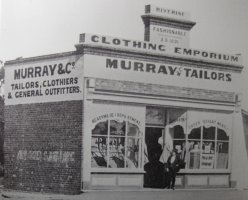
Murray's Corner in Hay, NSW, in c1874 and 2009
William Montague Murray in public life
In his later years, William Montague Murray became active in public life and had strong views, expressed in a colourful manner: “. . . for both at public meetings and in private, he spoke out with an eagerness, fluency and wit, that compelled attention whether his audience believed him right or wrong” (obituary in The Riverine Grazier, 24 January 1880).
In November 1871, a meeting was held regarding making Hay a municipality. Of 700 inhabitants, 100 attended the meeting. Murray was one of only two people who spoke out against the proposal. A petition was prepared by the residents and a committee was elected to work towards forming the township of Hay and the suburbs thereof into a municipality. Elections for aldermen were held in August 1872. At the first municipal meeting the local businessman, Frank Johns, was elected mayor.
. . . Mr Murray, (tailor and clothier) and Mr
Sorensen then addressed the meeting at some length against the
proposed municipality, contending - that it was too early for such
an institution - that corporations did more harm than good - that
they were made for friends of prominent public men - that the
frustration was not wanted, as government could do all that was
required - that Deniliquin Corporation had worked badly - that they
had there spent their money on goats - that the corporation had
impounded goats belonging to poor people - that municipalities did
not benefit the working classes, &c., &c., all of which were
answered by several speakers.
. . . The thanks of the meeting were then tended to Mr Jones, on the
motion of Mr Frank Johns, seconded by Mr James MacGregor, of the
Joint Stock Bank; remarking that when a municipality was sought for
by the men of property and older residents of the town, it could not
be successfully opposed by persons of only recent arrival, and who
might soon go away. (Hay Standard, November 1871)
In March 1872 , a meeeting was held regarding local issues, attended
by Mr Phelps, the local member of the NSW parliament:
. . . As to the objections to Mr Phelps, what
did they want of him –
he had worked if he did not speak. Did the
people of Hay want £500 a piece! (Mr Murray – “Mr Twynam wants to be
town clerk.”) He moved that Mr Phelps was a fit and proper person to
represent this constituency in Parliament.
Mr Twynam, in seconding the motion said, Mr Murray had announced
that he was filled with the transcendent ambition to be a town
clerk! That could go for what it was worth, but he had always done
his best for the town, and had kept Mr Phelps well informed of what
was wanted, and Mr Phelps had invariably attended to his
representations, (Mr Phelps corroborated the speaker.)
Mr Murray, the tailor at Hay, said he was a close observer of what
was going on, but he had never seen Mr Phelps's name in the ayes and
noes; he had never heard of him saying a word in the House. However,
he might for all that be a very estimable gentleman. The great want
of this district: is a railway from Echuca, but Sir James Martin
would rather make a railway from Dubbo to Bourke where you might go
fifty miles and not meet a dozen persons than he would have one made
from Echuca here, where it was so much wanted. The reason for
this is well known – Sir James Martin has a deadly hatred of
Victoria – he knew this very well, for he had known Jimmy Martin
ever since he was a clerk running with a blue bag for Bob Nicols. We
would never get justice from Sydney, therefore a part of this
territory should be cut off, and added to Victoria.
The motion was then put and carried that Mr Phelps was a fit and
proper person to represent this constituency in Parliament.
(Pastoral Times, 9 March 1872)
On Thursday 15 August 1872, a meeting was held at Carter’s Crown
Hotel to give all the candidates for the Municipal election an
opportunity to address the electors. W.M. Murray spoke and his
speech included much mud-slinging.
On 11 December 1872, a meeting was held at Carter’s Hotel at which Mr Twynam was
censured. Mr Murray likened Twynam to Frankenstein, as he had pushed
for Hay to be a municipality, but when he couldn’t get his chosen
people in, he’d turned against it, like Frankenstein against the
monster he’d created. Censure passed.
Letter published on 28 May 1873 from W.M. Murray complaining about a
J. Mathewson, regarding the Presbyterian church.
.jpg)
.jpg)
William Montague Murray
in recognition of his
PUBLIC SPIRIT
at the first
CONTESTED ELECTION
IN BALRANALD ELECTORATE
HAY, NSW, NOVR 12TH 1877
William Montague Murray’s gold fob watch, presented to him in
1877.
He was not a candidate, but was active in his support of
the local candidate from Hay, Colin William Simson, who was elected.
William Montague Murray marries again in 1878

On 4 November 1878, 58-year-old widower William Montague Murray married
40-year-old Naomi
Edwards. Nearly three years after his death, Naomi married again, to
John Mather of Stuart Mill, Victoria. She died in 1909 in St Arnaud,
Victoria.
William Montague Murray dies in Hay in 1880
 On
21 January 1880, William Montague Murray died in Hay, age 60, after
being bedridden for ten months with his first and only illness. His
obituary (below) has some inaccuracies, but gives an overall picture
of the life of this colourful man.
On
21 January 1880, William Montague Murray died in Hay, age 60, after
being bedridden for ten months with his first and only illness. His
obituary (below) has some inaccuracies, but gives an overall picture
of the life of this colourful man.
SACRED
TO THE MEMORY OF
WILLIAM MURRAY
WHO DIED 21ST
JANUARY 1880
AGED 60 YEARS
ERECTED AS AN AFFECTIONATE TRIBUTE
TO HIS WORTH BY HIS SON
DONALD
Montague Murray. – There passed from us and
from this mortal state, on Wednesday, 21st instant, at 7 p.m., Mr
William Montague Murray. The announcement will be read with real
sympathy by nearly every person in this district, and by numbers
over all Australia and New Zealand - for Mr Murray's previous
business of catering for public amusement, took him every place
where men do congregate. His pleasant buoyant and impulsive ways
will be missed, for both at public meetings, and in private, he
spoke out with an eagerness, fluency and wit, that compelled
attention whether his audience believed him right or wrong.
Deceased, who was best known as Montague Murray, was a native of
Glasgow, where he was educated at the Highland Society’s School, and
served his apprenticeship to the tailoring trade, in which he has
been very successful in Hay, and is succeeded by his son Donald
Murray. Early in life he acquired a taste for theatricals, and we
have listened with pleasure to his happy recital of humorous
incidents connected with the band of amateurs of which he was a
member. From Glasgow, he sailed with his wife to New Zealand as
tailor to the New Zealand Expedition Company in the ship “Bengal
Merchant” about 40 years ago, landing at Port Nicholson, where his
eldest child Donald was born – the first white child born on that
island, and the fifth in the whole of New Zealand
[not so; but he was amongst the first born at
Port Nicholson]. Mr Murray
afterwards did a flourishing business in Dunedin
[actually Nelson], as lessee of a
theatre and hotelkeeper; afterwards he moved to Sydney and to
Melbourne, from which places he made tours of the country with a
company of theatricals in his pay - money sometimes flowing in upon
him - at other times “dead broke”. Some 10 or 12 years ago the
writer met him in Deniliquin on his way to Hay, where he gave up his
professional rovings and settled down as a master tailor, in what
has proved his last home on earth. His last illness - which was
about the only one ever he had in his life, was very lingering – for
10 months he lay on his bed unable to turn himself, but he was
tended by kind and loving friends, and his intense sufferings from
pains in his legs and from bedsores – were mitigated and soothed as
much as human age could do. Farewell – good, eccentric, impulsive,
kind old man, may we meet again in a better, grander, happier world,
where we shall laugh at former foibles, and enjoy eternal life
without one drawback of sin or ignorance.
(The Riverine Grazier, 24
January 1880)

William Montague Murray
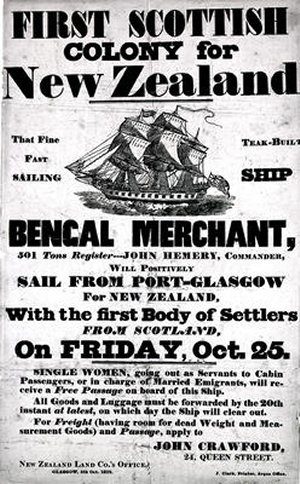
William Murray and Elizabeth McEwan
sailed on the Bengal Merchant
NZ Gazette and Wellington Spectator
19 December 1840
Nelson Examiner and NZ Chronicle
25 June 1842

Nelson Examiner and NZ Chronicle
15 October 1842
Nelson Examiner and NZ Chronicle
22 April 1843
Nelson Examiner and NZ Chronicle
27 April 1844
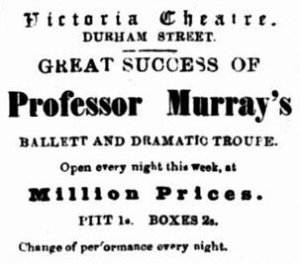
Bathurst Free Press and Mining Journal
5 February 1862
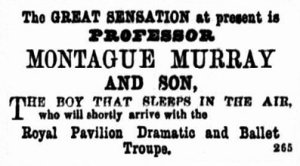
The Goulburn Herald and Chronicle
14 June 1862
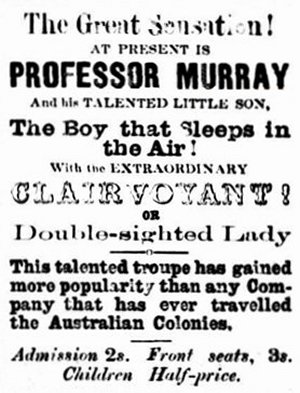
Queanbeyan Age and General Advertiser
21 August 1862
.jpg)
Queanbeyan Age and General Advertiser
21 August 1862
.jpg)
Queanbeyan Age and General Advertiser 21 August 1862
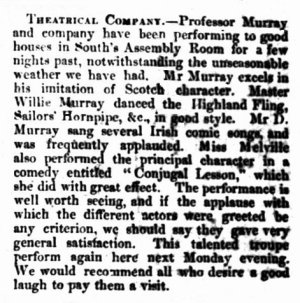
Border Watch (Mount Gambier)
18 December 1863

The Sydney Morning Herald
22 October 1864
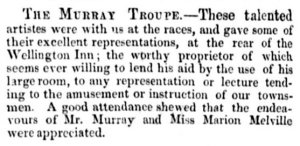
Clarence and Richmond Examiner and New England Advertiser (Grafton, NSW)
28 March 1865
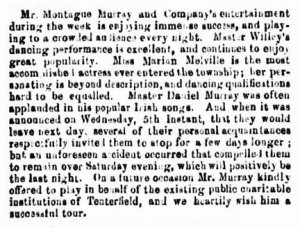
(Tenterfield) The Maitland Mercury & Hunter River General Advertiser
18 April 1865

The Goulburn Herald and Chronicle
7 February 1866
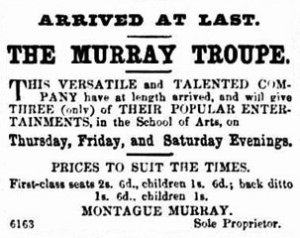
The Goulburn Herald and Chronicle
7 March 1866
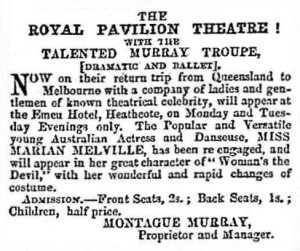
The McIvor Times and Rodney Advertiser (Heathcote, Vic) 3 August 1866
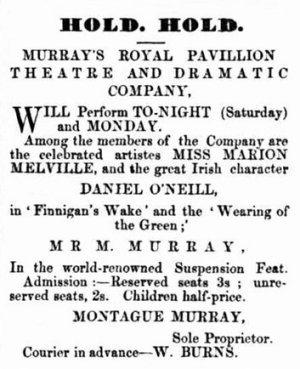
Border Watch (Mount Gambier, SA)
17 November 1866
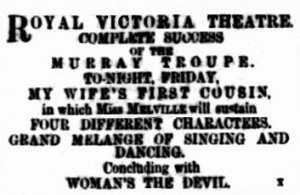
South Australian Register
27 December 1866

South Australian Register
27 December 1866

South Australian Register
29 December 1866
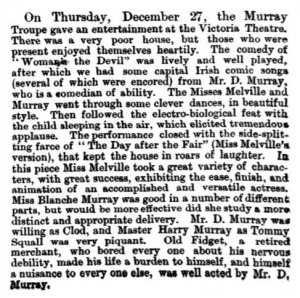
South Australian Weekly Chronicle
29 December 1866

South Australian Register
29 December 1866

The Argus, 15 July 1867
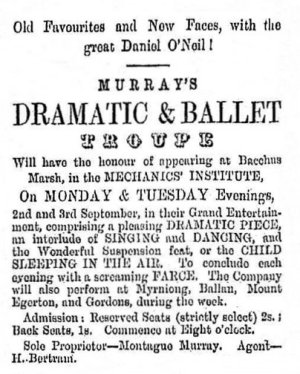
The Bacchus Marsh Express
31 August 1867

Wagga Wagga Advertiser and Riverine Reporter, 27 July 1870
The Riverine Grazier
19 November 1873

Murray's Corner, Hay, c.1874

Riverine Grazier, 2 December 1874
Riverine Grazier, 28 Dec 1878
.jpeg)
William Montague Murray